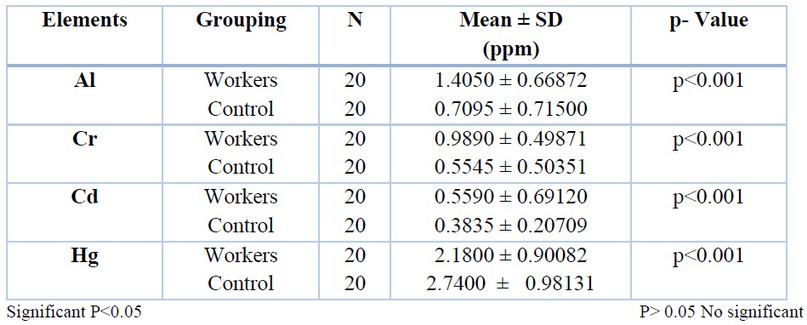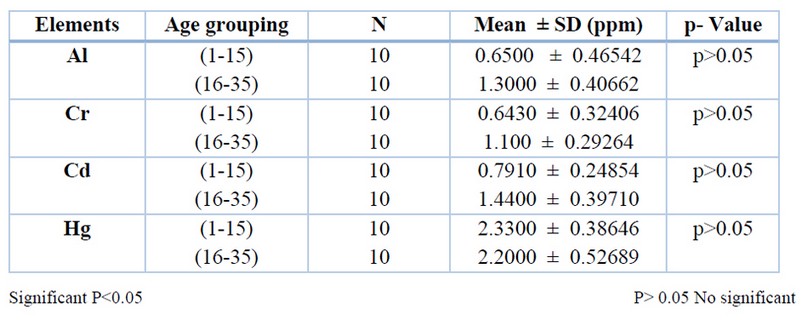Vol 7 No 2 2022- 4

Evaluation of Heavy Metal Pollution in the Blood Serum of Industrial Workers, Mosul, Iraq
1 Biology Department, Education College for Girls, University of Mosul.
2 College of Environmental Sciences and Technology, Depart. Of Environmental Sciences, University of Mosul. e-mail: dr.mazin@uomosul.edu.iq
3 College of Environmental Sciences and Technology, Depart. Of Environmental Sciences, University of Mosul. e-mail: salim.znad@yahoo.com
* Correspondence: salim.znad@yahoo.com
Available from: http://dx.doi.org/10.21931/RB/2022.07.02.4
ABSTRACT
The study was conducted in the two main industrial areas in Mosul, northern Iraq, where the study included measuring the number of heavy metals (cadmium, aluminum, mercury, chromium) in the blood of workers in those areas. For 20 workers, in contrast, blood samples were drawn from Mosul University employees. They were considered as a control group for being far from industrial activity and for 20 employees.
An atomic absorption device was used to analyze blood samples after diluting. In addition, workers were divided into groups according to (age, smoking status, and period of occupational exposure).
The results revealed statistically significant differences when comparing the samples of workers to the control group, while the results did not show significant differences between groups of workers.
Keywords. Pollution, Blood Serum, Industrial Area.
INTRODUCTION
Heavy elements are characterized by their toxic behavior when they exceed the permissible limit1, in addition to the fact that their effect on humans does not appear directly but after a period of time, and this is what gives them a cumulative character in the organs of the human body, causing many carcinogenic and mutagenic diseases and chronic infections such as lead, cadmium2,3.
These elements are released from two natural sources, represented by natural disasters, and the other source is human, represented by multiple human activities, primarily industrial, which results from the release of these elements into the environment, causing an imbalance in the ecological balance4,5. These chemical elements have been linked to several health issues faced the human. For example, in a person with liver disease, the continued exposure to these elements raises the harm to this organ6. The effect of the heavy metals is to interfere with the conformation of the protein in the body and with enzymes functions.7
The element mercury is characterized by its high toxicity, especially when inhaled, as it causes scratches and ulcers in the respiratory tract and is mainly produced from industrial processes..8,9
Cadmium is highly toxic and directly affects humans through smoking, as it enters as a central component of cigarettes and products by industrial plant emissions and contaminated food and water.10,11 Cd has a half-life period of 15-30 years and accumulates in the liver as the primary target tissue.12
Studies have shown that Cd damage to cells is caused mainly by reactive oxygen species (ROS) production.13 resulting in single-strand damage and destruction of nucleic acid.10 This toxic trace metal can cause liver or renal cell apoptosis in a low dose of exposure.14
Aluminum is one of the most abundant elements on the earth’s surface, especially in the soil. Because of its high importance, researchers pay great attention to it, especially considering that humans are mainly exposed to Al through drinking water, household goods, cosmetics, and drugs.15,16
Then, the (Al) ability to cross the blood-brain barrier features its tropism for the central nervous system.17,18 The Al exposure is one of the predisposing factors for changes in nervous tissue, promoting the degeneration of motor neurons, affecting learning, inducing excitotoxicity.19,20 modulating cell biochemistry and tissue integrity, and may drive behavioral dysfunctions.21,22
Researchers such as 23 They confirmed in their study about the measurement of heavy metals in human blood for those in the industrial areas, corresponding to the measurement of heavy metals in the blood of Mosul University employees as a control group, where the results showed that there are significant impairment and an apparent accumulation in the blood of industrial workers of heavy elements.
24also indicated in their study about measuring the concentrations of heavy metals (Pb, Co, Hg) in blood Serum that a highly significant increase of P<0.001 in the serum of the industrial areas compared with the control group.
MATERIALS AND METHODS
Study Area
The two main industrial areas of the city of Mosul are the manufacture of the Wadi Okab on the right side (the western part) and the Karama on the left side (the eastern part) (Figure 1).

Figure 1: Location of Study Area.
Study Design
The blood samples were taken from (20) industrial agents randomly in addition to taking blood samples from (20) people as a control group working at Mosul University without a history of industrial activity. The control group is not different from the group of workers in terms of gender and age groups.
Blood samples
Samples were collected on 14-10-2019 from 10 a.m. to 4 p.m. samples were taken from 20 workers in (plastic recycling plant, mechanics, car thighs). 20 samples were taken from those working at Mosul University as a control group. 5 ml of the blood of industrial workers was taken and delivered to the laboratory for examinations by means of an automatic absorption device after separating it and isolating the serum from it.
Statistical analysis
The data was processed using the statistical program spss.
RESULTS
The results showed significant differences for heavy metals (Al, Cr, Cd, Hg) elements. There is an apparent increase in the mix of elements measured in the industrial workers’ serum from the control group (Table 1).

Table 1. Heavy metals concentrations in industrial workers and control group
The group of industrial workers has been classified according to (age groups, smokers and non-smokers, occupational exposure period). Age groups (1-29) years and (30-57) showed the results to lack significant moral differences. (Table 2).

Table 2. Determination of heavy metals between two ageing group of workers.
For the smokers and non-smokers category of the industrial workers’ group, the results showed no significant differences between the two categories for the measured elements (table 3).

Table 3. Determination of heavy metals between smokers & non-smokers of workers.
Regarding the occupational exposure period category (1-19) and (20-39) years for the industrial group and all measured elements, the results showed that there were no significant differences. (Table 4).

Table 4. Determination of heavy metals between workers depending on the work period.
DISCUSSION
Because of the severe and cumulative toxicity of heavy metals, they pose a tremendous and real threat to all living organisms, including humans, as many diseases and epidemics occur to them and accumulate inside human organs for extended periods according to the occupational exposure of people, which results in cancers that infect and damage organs25,26.
CONCLUSION
Industrial workers face an imminent danger of death due to the high concentrations of heavy metals to which they are exposed, and this requires rapid and urgent intervention from all health and environmental sides to protect them.
Funding: self-funding
Conflicts of Interest: there is no conflict
REFERENCE
1. Bernard, A., 2004. Renal dysfunction induced by cadmium: biomarkers of critical effects. Biometals290 17, 519-523.
2. Bose-O’Reilly (2010) . Mercury exposure and children’s health. Curr Probl Pediatr Adolesc Health Care. 2010;40(8):186–215.
3. Dooyema CA, Neri A, Lo YC, Durant J, Dargan PI, Swarthout T, Biya O, Gidado SO, Haladu S, Gwarzo NS, Nguku PN, Akpan A, Idris S, Bashir AM, Brown MJ(2012). Outbreak of fatal childhood lead poisoning related to artisanal gold mining in north-western Nigeria, 2010. Environ Health Perspect [Internet]. 2012 Apr [cited 2015 May 25].
4. Eck, P. and Wilson, L., (1989). Toxic Metal In Human Health And Disease. Applied Nutrition and Bioenergetics, Ltd., 8650 N.
5. Eisler R. (2004). Mercury hazards from gold mining to humans, plants, and animals. Rev Environ Contam Toxicol. 2004; 181:139–98.
6. Fernandez-Lorenzo JR (1999) Aluminum contents of human milk, cow’s milk, and infant formula. J Pediatr Gastroenterol Nutr 28(3):270–275
7. Gauthier E, Fortier I, Courchesne F, Pepin P, Mortimer J,Gauvreau D (2000) Aluminum forms in drinking water and risk of Alzheimers disease. Environ Res 84(3):234–246.
8. Kozlowski H, Brown DR, Valensin G (2007) Metallochemistry of neurodegeneration: biological, chemical and genetic aspects.Royal Society of Chemistry, London
9. Matović, V., Buha, A., Ðukić-Ćosić, D., Bulat, Z., 2015. Insight into the oxidative stress induced by lead and/or cadmium in blood, liver and kidneys. Food Chem. Toxicol. 78, 130-140.
10. Mitra, R., 1984. Protein synthesis in Escherichia coli during recovery from exposure to low levels of Cd2+. Appl. Environ. Microbiol. 47, 1012-1016.
11. Morris G, Puri BK, Frye RE (2017) The putative role of environmentalaluminium in the development of chronic neuropathology in adults and children. How strong is the evidence and what could be the mechanisms involved? Metab Brain Dis 32(5):1335–1355
12. Olujimi O, Steiner O, Goessler W. (2015). Pollution indexing and health risk assessments of trace elements in indoor dusts from classrooms, living rooms and offices in Ogun State, Nigeria. J Afr Earth Sci [Internet]. 2015 Jan [cited 2015 May 25]; 101:396-404.
13. Rashed MN. (2008). Total and extractable heavy metals in indoor, outdoor and street dust from Aswan City, Egypt. Clean – Soil, Air, Water [Internet]. 2008 Nov [cited 2015 May 25];36(10-11):850-7.
14. Saba K (2017) Energetics of excitatory and inhibitory neurotransmission in aluminum chloride model of lzheimer’s isease: reversal of behavioral and metabolic deficits by Rasa Sindoor. Front Mol Neurosci 10:323
15. Satarug, S., Moore, M.R., 2004. Adverse health effects of chronic exposure to low-level cadmium in foodstuffs and cigarette smoke. Environ Health Perspect 112, 1099-1103.
16. Sun G, Li Z, Bi X, Chen Y, Lu S, Yuan X. (2013). Distribution, sources and health risk assessment of mercury in kindergarten dust. Atmospheric Environ [Internet]. 2013 Jul [cited 2015 May 25];73:169-76.
17. Stohs, S., Bagchi, D., 1995.oxidative mechanisms in the toxicity of metal ions. Free Radic. Biol. Med.18,321-336.
18. Tamara J., Mariea and George L. Carlo (2007). Wireless Radiation in the Etiology and Treatment of Autism :Clinical Observations and Mechanisms.J.Aust coll Nutr. &Env.Med Vol .26 No.2 3-7.
19. Tower, S. S., (2010). Cobalt Toxicity in Two Hip Replacement Patients. Bulletin. No. (14): 28.
20. Verougstraete, V., Lison, D., Hotz, P., 2003. Cadmium, lung and prostate cancer: a systematic review of recent epidemiological data. J Toxicol Environ Health B Crit Rev 6, 227-255.
21. Walton J (1995) Uptake of trace amounts of aluminum into the brain from drinking water. Neurotoxicology 16(1):187–190.
22. Yokel RA, McNamara PJ (2001) Aluminium toxicokinetics: an updated minireview. Pharmacol Toxicol 88(4):159–167.
23. Znad, Salim Rabee. and Al-Sinjary, MazinNazar (2020). The vital accumulation of some Heavy metals in the blood serum of industrial zone workers in Mosul city. Plant Archive journal volume 20. Supplement 1 , 2020 .pp 3194- 3200 .
24. Znad, Salim Rabeea, Fadhel, Mazin Nazar, ÜNŞAR, Ayça ERDEM (2021). Investigate workers’ health in the western industrial region, Mosul, Iraq. Revesta Bionatura journal., ISSN 1390-9347, 2021, Pages.1983-1985, Received: 18 May 2021, Accepted: 11 July 2021. DOI. 10.21931/RB/2021.06.03.16
25. Yokel RA (1996) Prevention and treatment of aluminum toxicity including chelation therapy: status and research needs. J Toxicol Environ Health 48(6):667–684
26. Zheng J, Chen KH, Yan X, Chen SJ, Hu GC, Peng XW, Yuan JG, Mai BX, Yang ZY(2013). Heavy metals in food, house dust, and water from an e-waste recycling area in South China and the potential risk to human health. Ecotoxicol Environ Safety [Internet]. 2013 Oct 1 [cited 2015 May 25];96:205-12.
Received: 14 November 2021 / Accepted: 20 February 2022 / Published:15 May 2022
Citation: Fathi Al-Obaidi R, Nazar Fadhel M, Rabeea Znad S. Evaluation of Heavy Metal Pollution in the Blood Serum of Industrial Workers, Mosul, Iraq. Revis Bionatura 2022;7(2) 4. http://dx.doi.org/10.21931/RB/2022.07.02.4




















